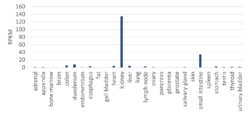Biology:FAM151A
 Generic protein structure example |
Family with sequence similarity 151 member A (abbreviated FAM151A) is a protein that in humans is encoded by the FAM151A gene. The protein is a transmembrane protein expressed in the kidney tubules, and is an ortholog of menorin, a protein involved in neuron development in nematodes.[1][2]
Gene

The FAM151A gene contains 8 exons and is located on the minus strand of chromosome 1 at 1p32.3, spanning approximately 14 kbp.[3][4] The last exon contains approximately half of the coding sequence, and overlaps with the 3' UTR of gene ACOT11.[5] No alternative splicings of FAM151A are known.
Expression


The mRNA transcript of FAM151A is expressed in the kidney, small intestine, and liver, while the FAM151A protein is only expressed in kidney tubules.[6]
Protein

The FAM151A protein contains three known domains, one transmembrane domain and two domains of unknown function DUF2181.[7] DUF2181 is a member of the GDPD/PLCD superfamily, which are known to hydrolyze glycerophosphodiester bonds.[8] The second DUF2181 of FAM151A is hypothesized to be nonfunctional through homology analysis. The molecular weight of FAM151A is known to be approximately 95 kDa.[9]
Evolutionary history

Orthologs of FAM151A
FAM151A has direct orthologs in chimpanzee,[10] mouse,[11] zebrafish,[12] and other members of the clade Eumetazoa that diverged from humans up to around 700 million years ago.[13][14] However, FAM151A does not have any known orthologs in birds.
Protein family FAM151/Menorin
FAM151A has one known paralog in humans, FAM151B, which contains only the first DUF2181 and no transmembrane region.[15] In mammals, both FAM151A and FAM151B are homologs of the C. elegans menorin gene, involved in dendrite branching.[8][2]
Clinical significance
FAM151A contains an SNP, rs11206394, that is a significant predictor of colorectal cancer. The SNP is a missense mutation that occurs in the region of the second DUF2181 of FAM151A that overlaps with the 3' UTR of ACOT11. Individuals with both copies of the minor allele have been observed to have the odds of cancer decreased between 11% and 59%.[16]
References
- ↑ Prunotto, Marco; Farina, Annarita; Lane, Lydie; Pernin, Agnès; Schifferli, Jürg; Hochstrasser, Denis F.; Lescuyer, Pierre; Moll, Solange (2013-04-26). "Proteomic analysis of podocyte exosome-enriched fraction from normal human urine" (in en). Journal of Proteomics 82: 193–229. doi:10.1016/j.jprot.2013.01.012. ISSN 1874-3919. PMID 23376485. https://www.sciencedirect.com/science/article/pii/S1874391913000407.
- ↑ 2.0 2.1 Ziegenfuss, Jennifer S.; Grueber, Wesley B. (2013-10-10). "SAX-7 and Menorin Light the Path for Dendrite Morphogenesis" (in English). Cell 155 (2): 269–271. doi:10.1016/j.cell.2013.09.029. ISSN 0092-8674. PMID 24120127.
- ↑ "Homo sapiens family with sequence similarity 151 member A (FAM151A), m - Nucleotide - NCBI". 16 February 2021. https://www.ncbi.nlm.nih.gov/nuccore/NM_176782.3.
- ↑ "Genecards Entry on FAM151A". https://www.genecards.org/cgi-bin/carddisp.pl?gene=FAM151A&keywords=fam151a.
- ↑ 5.0 5.1 "NCBI Gene Entry on FAM151A". https://www.ncbi.nlm.nih.gov/gene/338094.
- ↑ "Human Protein Atlas entry on FAM151A". https://www.proteinatlas.org/ENSG00000162391-FAM151A.
- ↑ "protein FAM151A [Homo sapiens - Protein - NCBI"]. https://www.ncbi.nlm.nih.gov/protein/NP_788954.2.
- ↑ 8.0 8.1 Findlay, Amy S.; McKie, Lisa; Keighren, Margaret; Clementson-Mobbs, Sharon; Sanchez-Pulido, Luis; Wells, Sara; Cross, Sally H.; Jackson, Ian J. (2020-01-16). "Fam151b, the mouse homologue of C.elegans menorin gene, is essential for retinal function" (in en). Scientific Reports 10 (1): 437. doi:10.1038/s41598-019-57398-4. ISSN 2045-2322. PMID 31949211. Bibcode: 2020NatSR..10..437F.
- ↑ "FAM151A Antibody (PA5-53502)". https://www.thermofisher.com/antibody/product/FAM151A-Antibody-Polyclonal/PA5-53502.
- ↑ "NCBI protein entry on FAM151A [Pan troglodytes"]. https://www.ncbi.nlm.nih.gov/protein/XP_016774503.1.
- ↑ "NCBI protein entry on FAM151A [Mus musculus"]. https://www.ncbi.nlm.nih.gov/protein/NP_666261.1.
- ↑ "NCBI protein entry on FAM151A [Danio rerio"]. https://www.ncbi.nlm.nih.gov/protein/NP_001093565.1.
- ↑ "NCBI protein entry on FAM151A [Lingula anatina"]. https://www.ncbi.nlm.nih.gov/protein/XP_013411281.1.
- ↑ "TimeTree :: The Timescale of Life". http://www.timetree.org/.
- ↑ "NCBI Protein Entry on FAM151B". https://www.ncbi.nlm.nih.gov/protein/NP_991111.2.
- ↑ "Impact of Genetic Variation in MicroRNA-binding Site on Susceptibility to Colorectal Cancer". Anticancer Res 36 (7): 3353–61. July 2016. PMID 27354594.
 |
